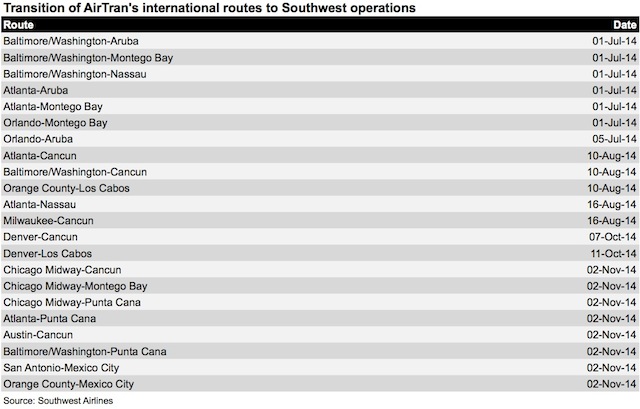Southwest Airlines has launched its first international flights, and will likely announce new international destinations as soon as late this year.
The Dallas-based carrier started to take over subsidiary AirTran Airways’ international flights beginning on 1 July, as it works to integrate AirTran’s operations into its own by year-end, upon which the AirTran brand will be retired.
AirTran had served seven international destinations in its network, all in Mexico and the Caribbean: Los Cabos, Mexico City, Cancun, Nassau, Montego Bay, Punta Cana and Aruba.
By the end of this week, Aruba will be completely converted to Southwest, with service to Baltimore/Washington, Atlanta and Orlando. The remaining international destinations will be converted by year-end.
Southwest's international routes, post-AirTran integration

Source: FlightMaps Analytics
Southwest has dropped hints in the past about where else it could possibly fly to with its new international capabilities – Southwest brought on Amadeus to supply a new reservations system so it can sell AirTran’s international flights – and right now, it looks as if the world could indeed be Southwest’s oyster.
“It’s really anywhere that the [Boeing] 737 can fly,” says Evan Berg, Southwest’s senior manager of international business management. Possible markets include more in the Caribbean, Central America, the northern realm of South America, and Canada, says Berg.
“We are focused on converting AirTran markets in 2014. We will look to expand further in 2015, and we could announce new markets as soon as end-2014,” he adds. Berg was speaking with Flightglobal on Southwest’s first flight from Baltimore/Washington to Nassau, which transitioned to the airline from AirTran on 1 July.
Potential new destinations in Latin America include cities in countries like Colombia and Peru, says Berg. These could be major cities like Bogota and Lima. “We are looking for large O&D [origin and destination] markets,” he says. “These will be served from places where we are building international gateways.”
These international gateways Berg refers to include Fort Lauderdale and Houston Hobby, where Southwest is either funding or overseeing airport improvements. At Fort Lauderdale, the carrier is managing a makeover of terminal one to allow it to handle international flights, to be ready in 2017.
At Houston Hobby, Southwest is funding a new terminal to enable the airport to handle international flights. The airline is targeting for the terminal to be completed in the fourth quarter of 2015.
Baltimore/Washington has also grown to be one of Southwest’s international gateways. The airline, once done with converting AirTran’s international destinations to its own metal by year-end, will serve Aruba, Cancun, Montego Bay, Nassau and Punta Cana from Baltimore/Washington.
New destinations in the Caribbean that Southwest is studying include Grand Cayman, Curacao and the US Virgin Islands, says Berg. These markets are in line with Southwest’s targeted segment of international passengers – the American leisure customer.
“We also, of course, look for markets that provide business synergies between foreign cities and the US cities we serve, as well as VFR [visiting friends and relatives] traffic,” he adds. Berg estimates that more than 80% of passengers flying internationally on Southwest originate in the USA.
In Mexico, Berg reckons logical new destinations include key business centres like Monterrey and Guadalajara as well as leisure destinations such as Puerto Vallarta and Cozumel.
Southwest recently wrote to the US Department of Transportation, asking the agency to guarantee competition on the Houston-Puerto Vallarta and Houston-Los Cabos routes if Southwest or another airline chooses to operate in those markets in the future. United Airlines and its affiliates currently hold two of the three designations to operate on those routes.
Berg says the airline has not concluded it will necessarily serve those markets, but that it wants the DOT “to know we would have interest”.
For Canada, Southwest is studying “major business markets” like Vancouver, Toronto, Edmonton and Montreal. These will likely be served from Southwest’s northern gateways in the USA, says Berg.
International flights now make up less than 1% of Southwest’s total available seat miles, but this is likely to grow to 3-5% in the next three to five years.
Southwest does not currently interline or codeshare with any foreign carriers, but has not ruled this out, once all of its reservations systems are harmonised. The carrier announced in May that Amadeus will provide its new domestic reservations system, after selecting Amadeus for its international reservations system.
Amadeus will help the airline standardise all of its reservations systems. Southwest is using Sabre for its domestic flights, while AirTran’s domestic flights are being sold on Navitaire. Southwest has said it plans to use the two domestic systems to sell flights until the AirTran brand is phased out by year-end.
Berg says interlining and codesharing with foreign airlines will be out of the question until the airline’s reservations systems are standardised. But the airline has received expressions of “keen interest” from various international carriers to work together. “A lot of airlines have expressed interest. There is keen interest to connect to our domestic network,” he says.
Air China, for one, told Flightglobal in June that it had approached Southwest as a codeshare partner but that the latter’s IT infrastructure is not ready for such a deal yet.
Berg says Southwest will study the international marketplace for potential partners once its reservations systems are ready. “By the time we get the capabilities, we will study – what do the alliances look like? What opportunities exist to connect the networks?”

Source: Cirium Dashboard
















